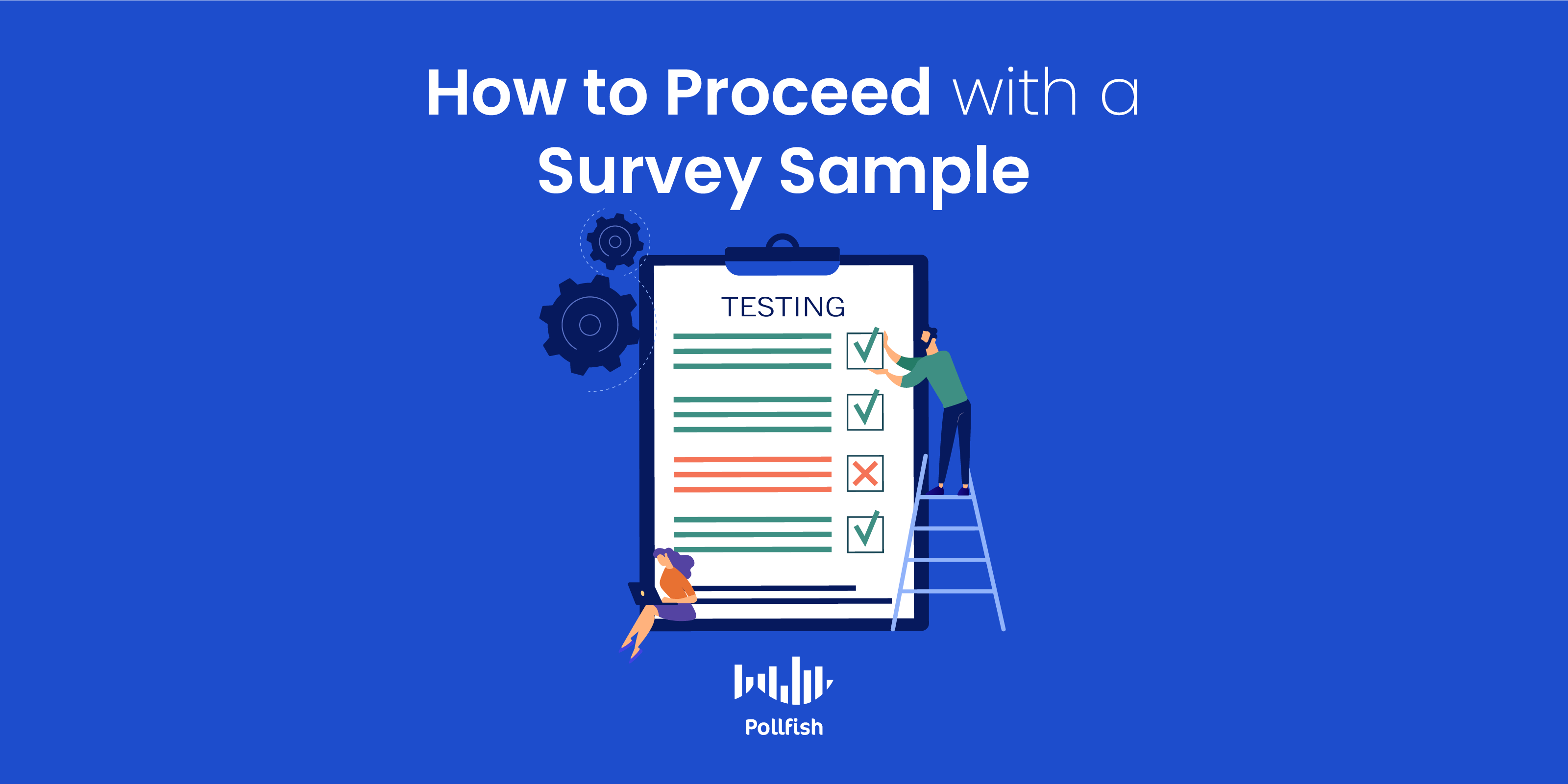How to Find and Obtain a Survey Sample for Accurate Market Research

A survey sample is a critical batch of respondents studied in market research campaigns. Given that this group forms the core of any campaign, it needs to be dealt with correctly.
This involves extracting the sample, reaching out to it across various digital properties, analyzing it and moving forward with all the necessary steps to generate effective survey studies.
As such, market researchers and marketers should be acquainted with the various survey sampling methods used to obtain a survey sample and all of its other particulars.
This article provides insights into the survey sample, including how to collect one and proceed with analysis and other crucial next steps.
Defining the Survey Sample
Also called the survey pool, a survey sample is a group of participants who take part in a market research study, specifically, a survey study.
As its name suggests, this sample is derived from the method known as survey sampling, in which researchers extract respondents to represent a population of study. There are various methods and sub-methods involved in survey sampling.
In market research, the survey sample comprises a business’s target market, that is, a portion of a market population that is most willing and likely to purchase from the business. As such, all marketing efforts are directed at this group of the population.
A survey sample does not have to be broad, meaning that it does not necessarily need to study all the members that make up a target market. Instead, it can be composed of a specific segment of a target market.
In order to procure this segment, researchers must perform market segmentation.
Understanding the Various Ways to Obtain a Survey Sample
As aforementioned, there are various ways to acquire a survey sample, one of the most critical preliminary steps in conducting market research techniques.
Acquiring a survey sample includes two major undertakings:
- Deciding on the makeup of the survey sample itself
- Choosing a method to obtain the survey sample
The former involves determining who will take part in the sample and how many respondents to include in the sample. The latter is known as survey sampling and it entails garnering the members of a target population to take part in a survey study.
In regards to the latter, there are two main methods of survey sampling: probability and random sampling. First, you will need to identify the makeup and scope of your survey pool. Then, you can move forward with it by deciding on a survey sampling method to obtain the pool.
The following explains how to carry out the formation of the survey sample.
How to Choose the Makeup of the Survey Sample Itself
In reference to the above section on understanding the ways to obtain a survey sample, the second aspect of acquiring a sample — after choosing between the probability and non-probability sampling methods — is to decide who should be in the survey sample itself and how big it should be.
In order to decide on the makeup of the sampling pool, follow these steps.
- Refer to the purpose of your market research campaign.
- Ask yourself, what are its main themes and variables, along with its appropriate macro markets.
- For example: To learn how to market a new product to middle-aged adults in the US, your target market, or target population is middle-aged adults in the US.
- Decide whether you are looking to study the wider target population, or if it is more convenient for your business to study a particular segment of the population of interest.
- In this case, you would need to conduct market segmentation.
- You can also perform market research to reach the correct target market sample.
- Determine your accuracy requirements. This involves understanding the degree of the risk your survey study will take in terms of receiving answers that do not accurately describe the entire population.
- This is because you won’t be surveying the entire population.
- To determine how closely your answers reflect the views of your studied population, you’ll need to calculate the margin of error.
- Ex: If your margin of error is 4%, that means 4% is added on both sides of the results of your survey sample. So if 70% of your sample likes shopping online, then the results show that 66-74% of your sample actually likes online shopping.
- Your margin of error should be kept under 10% to maintain quality findings.
- Find the proper confidence interval. Also called the confidence level, this metric shows the likelihood of the sample you used matters in your results, as repeated studies would form the same results.
- For example, a 95% confidence level would yield the same results 95% of the time.
- 95% is the most common confidence level used in statistics. The ideal confidence level range is between 90-99%. Anything lower than 90% is not recommended.
- Finally, decide on the most fitting survey sampling method to extract your survey pool.
The Two Main Methods for Obtaining a Survey Sample
Once you’ve identified the makeup of your survey sample, you’ll need to deploy your surveys. To do so, you must decide on a method for obtaining your survey sample. The following explains the two main types of survey sampling methods.
Market researchers ought to understand these methods and all that they entail before initiating any market research campaign. Being versed in these methods will help guide your study.
Probability Sampling
Also called random sampling, this method involves giving every member of a studied population an equal chance of being selected in the survey sample. In order to select the respondents, researchers would use a random process, in which selected participants are presented as unbiased representations of the total population.
Probability sampling has several more complex sub-methods, such as stratified sampling, which involves selecting participants from subgroups of a population, such as those based on age, location, ethnicity, interest, etc. There are various other methods that makeup probability sampling.
Random sampling aims to gain a sample that represents an entire population of study. Therefore, the results of the study must be generalizable to the studied population. As such, this method is viable for quantitative market research, since it is focused on understanding a larger population by studying a much smaller subset.
This kind of sampling is therefore not ideal for qualitative market research, which seeks to elucidate a specific group of people, without generalizing the findings to a larger population.
Non-Probability Sampling
Also referred to as non-random sampling, non-probability sampling acts antithetically to probability sampling, as it does not use random means to select respondents. Thus, the members of a studied population do not have an equal chance of being selected; some of them will have no chance of being selected.
This main sampling method also has several of its own methods, such as convenience sampling, in which participants are selected if they are readily available and willing to participate. For example, if your study requires studying librarians and you only select those in your zip code, as opposed to those across geographic locations.
All procedures that avoid random selections and involve the judgment of the researchers fall under the non-probability sampling method. As such, even an online survey platform — which has a far wider reach than focus groups or one-on-one interviews — is considered a non-probability sampling tool. This is because in such a platform, the survey sample is not derived from every member of the target population. These kinds of platforms may also not rely on random processes.
One of the most powerful forms of non-probability sampling is organic sampling or Random Device Engagement. This method procures respondents organically, that is, it reaches them in their natural digital settings, as opposed to using survey panels, a sampling method that involves pre-recruiting a set of respondents.
RDE polling engages digital users where they are voluntarily; as such, participants join on their own will and can be found on a vast network of publishing websites and apps. Thus, although the respondents aren’t extracted through organic means, RDE still offers a survey sample that joined through organic settings.
How to Proceed with a Survey Sample
After determining the correct people to use for your survey sample, choosing which sampling method is best, along with the correct sub-method to use, launch your survey. Then analyze your initial results by performing a survey data analysis.
This will be the preliminary analysis, as based on your findings, you may need to conduct another survey, either on the same group or on a specific segment of your target market, if your study was aimed at your general target market.
 If you surveyed a segment of your target market, you may need to study another to compare the two. Perhaps some segments are more inclined to generate customer loyalty than others.
If you surveyed a segment of your target market, you may need to study another to compare the two. Perhaps some segments are more inclined to generate customer loyalty than others.
If you discovered a particular behavior from your survey studies that require further studying, consider embarking on experimental research. This will help you prove whether there are correlational factors at play between your variables.
Once you’ve received a valuable share of insights, take action. A valuable amount will differ from company to company and research campaign to research campaign. Consider the findings of your survey studies. If they point to the utility in certain actions, especially if those actions seem prospective for your study or business at large, then take them. The goal of a survey sample is to forge ahead in your market research, which should always be actionable.
Leading the Charge on Your Survey Pool
The survey sample, also referred to as the survey pool, is indispensable for all market research campaigns, as those of the present-day usually rely on survey research. As the core of the survey campaign, the survey sample will determine the accuracy of the entire market research operation.
As such, it must be identified carefully and obtained properly. Aside from the actions to take in regards to these practices, another crucial factor in developing surveys for the correct survey sample is an online survey platform. Such a platform should not simply allow you to create surveys and deploy them, but to reach the correct people, i.e., your survey sample.
A potent online survey platform will allow you to choose the respondents making up your survey pool in the screening or audience section of the survey tool. In this section, you should be able to add and filter the respondents you seek on a variety of categories, including demographics, psychographics and geolocation.
The key is to choose the correct online survey provider.
Pollfish Marketing Team
Ready to Try Pollfish?
Create your survey with AI, target high-quality respondents starting at $0.95 per complete, and start getting results in just minutes in real-time. From running a simple product concept survey to managing a constant stream of trackers for dozens of clients in dozens of countries, we’ve got you.

